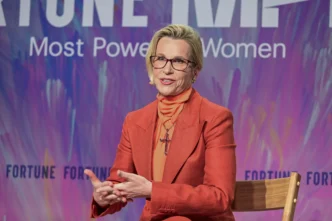The era of endless equity-fueled growth in technology may be slowing, and a new phase of leveraged risk could be taking over. That is the warning from Morgan Stanley Wealth Management Chief Investment Officer Lisa Shalett, who says the increasing reliance on debt financing in the artificial intelligence sector is a sign that the tech bull market is weakening from within.
“Debt is becoming a substitute for slowing capital inflows,” Shalett cautioned. “That is not a sign of healthy expansion—it’s a sign of shrinking liquidity and rising desperation.”
While tech giants continue to post strong earnings and investors remain fixated on AI as a transformative economic force, the growing presence of leveraged funding—loans, private credit, and convertible debt—in AI infrastructure and startups suggests that the traditional appetite for equity investment may be cooling.
AI: Booming Business With Rising Borrowing
The AI economy continues to experience record capital demand. Cloud expansion, AI chips, data centers, and GPU clusters require billions in upfront buildout costs. But in 2025, the tone of funding has shifted:
- AI and cloud infrastructure borrowing is accelerating—tech firms raised more than $60 billion in debt over the past six months alone.
- Private credit funds—normally associated with real estate and industrial lending—have entered the AI race.
- Convertible bonds issued by tech firms have surged, reflecting investor caution toward equity valuations.
“AI is real. But its economic timeline is long,” said one senior venture lender in Silicon Valley. “Private capital is now bridging that gap with debt—because equity investors are pulling back.”
Why Now? High Rates, High Hype, Slowing Returns
The AI gold rush is colliding with a changing macroeconomic environment:
| Market Force | Impact on AI Financing |
|---|---|
| High interest rates | Makes capital more expensive and raises risk |
| Slowing VC investment | Pushes startups toward private lending |
| Crowded AI startup space | Dilutes investor conviction |
| Scarcity of GPUs & cloud costs | Forces firms to borrow heavily |
| Slower monetization timelines | Delays returns, increases leverage |
Morgan Stanley’s Shalett argues that these conditions indicate a late-cycle dynamic, where investors begin to rely on leverage to maintain the illusion of growth. “We’ve seen this story before,” she noted. “Late-stage funding gets more complex and more structured when the easy money dries up.”
A Warning Sign Before a Correction?
While big tech leaders like Microsoft, Apple, and Nvidia maintain fortress balance sheets, the rest of the AI universe is increasingly leaning on lenders. Analysts warn this could trigger the next correction:
- AI startup valuations are still inflated—despite unproven revenue models.
- Burn rates are accelerating, especially among GPU-heavy models and enterprise AI SaaS platforms.
- Debt servicing pressure could wipe out weaker players in a downturn.
“AI may not crash,” one hedge fund strategist noted, “but the AI startup market will fragment fast. Those without cash flow or strategic partnerships won’t survive.”
The Rise of “Debt-Driven Innovation”
A quiet transformation is underway in Silicon Valley. Private debt funds—once bystanders in tech—are now essential players in the AI economy.
- Non-bank lenders now account for 35% of corporate financing in private markets.
- They offer flexible, high-interest loans for AI buildout and GPU purchases.
- Debt clauses now often include IP claims and equity triggers—giving lenders future ownership stakes.
“What you’re seeing,” says Shalett, “is a transfer of power. Equity investors are losing control of AI’s future to financiers. That has consequences.”
AI Remains Inevitable—but Capital May Get Selective
Despite rising risks, no one is calling an end to AI momentum. Instead, strategists expect a shift from speculative AI to industrial AI—where capital flows to companies with measurable commercial use cases.
AI sectors likely to thrive:
- Enterprise automation
- AI cybersecurity
- AI for healthcare and biotech
- Government and defense AI
- AI-driven manufacturing and robotics
AI sectors at risk:
- Consumer chatbot startups
- Unmonetized AI platforms
- GPU rental “middlemen”
- AI content generators
“Innovation cycles don’t end,” says Shalett. “But speculative phases do.”
What Investors Should Watch
Morgan Stanley advises watching three signals to determine if the AI rally is evolving—or unraveling:
| Signal to Monitor | Risk Interpretation |
|---|---|
| Debt-to-equity ratios rising | Liquidity pressure, falling cash |
| More AI firms issuing convertibles | Equity hesitancy growing |
| Private credit fund exposure spikes | Risk migrating to shadow lenders |
If these trends accelerate, the AI market could face a leverage unwind similar to what the tech industry experienced after the dot-com boom—not a collapse, but a consolidation.
Final Outlook
AI remains one of the most powerful investment themes of the decade—but it is entering a more dangerous financial phase. Shalett’s warning is not about AI technology—but about capital discipline.
“AI will transform the global economy,” she said. “But the capital behind AI must transform too. If we rely on leverage instead of fundamentals, the market will correct. That’s not fear—it’s financial reality.”
















